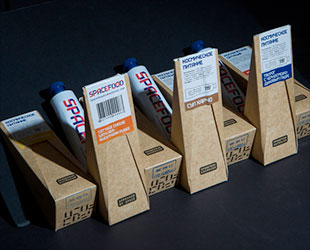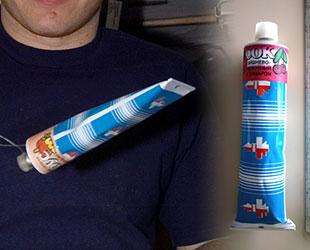Feb. 6, 2015 — Move over astronaut ice cream, Russian space food tubes have arrived.
As of Friday (Feb. 6), the All-Russian Exhibition Center in Moscow now sells authentic cosmonaut food to the public, the state-run Sputnik news service reported. The center, a sprawling trade show also known by the Russian acronym VDNKh, is marketing the cosmic cuisine in toothpaste-like tubes.
"Visitors [to VDNKh] will have a chance to try a full-course cosmonaut menu, including four kinds of soups, various meat dishes and a variety of desserts," the Sputnik report said. "According to organizers, there will be 11 variations of tubes, each tasting like a different kind of food."
The selection, according to the Russian website Menu.ru, include marinated lamb and pork with vegetables, cottage cheese dessert with sea buckthorn fruit, and apricot, apple and blackcurrant puree.

The space food tubes are produced by the Biruliovsky pilot plant, the main supplier of food for Russian cosmonauts. (Menu.ru) |
The tubes, which are offered through a vending machine, cost 300 rubles, or about $4.50, each. They are produced by the same factory and using the same methods as the food that is prepared for the Russian cosmonauts onboard the International Space Station.
"Producers do not use any genetically-modified products and assure that the food in the tubes is made from natural ingredients only," the news service noted.
Space food packaged in tubes was common to both the early Russian and American crewed flights of the 1960s.
Cosmonaut Yuri Gagarin, who in April 1961 became the first human to launch into space, had tubes of meat paste and chocolate sauce aboard his Vostok capsule. Similarly John Glenn, the United States' first astronaut in orbit and the first NASA astronaut to eat any type of food in space, had pureed beef and vegetables packed into an aluminum tube on his February 1962 Mercury mission.

Aboard the International Space Station, Russian cosmonauts use space food tubes to consume soup and drinks. (NASA) |
On NASA space missions, squeeze tubes soon gave way to plastic packages and foil-lined pouches. Russian flights also transitioned to canned foods and plastic pouches for their cosmonaut meals, but still employed tubes for soups (like borscht) and drinks.
The new VDNKh vending machine is not the first time that space food samples have been sold to the public. Boxed Russian cosmonaut meals have been offered in the past and freeze-dried American foods, including "astronaut" ice cream (which flew into space only once, onboard Apollo 7 in 1968) are commonly offered in museum gift shops.
Other nations' space edibles have also gone commercial, including Japanese, Korean and Chinese samples, as well as dishes prepared for the European Space Agency's crew members.
The VDNKh exhibition center includes the Monument to the Conquerors of Space and Cosmonautics Museum, and recently became the new home to the Buran space shuttle that for years was exhibited at Gorky Park. The addition of the space food vending machine is the first part of a new renovation to the complex's space pavilion.
